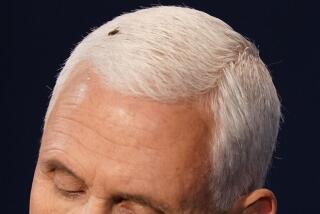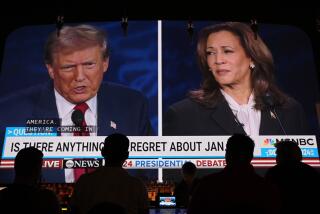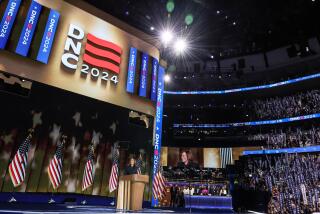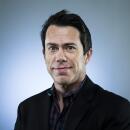Split Screen Wasn’t Kind to Bush
- Share via
WASHINGTON — The split screen gave the GOP fits.
On the day after the first presidential debate, many Republicans fretted that side-by-side images of President Bush and Sen. John F. Kerry drew attention to the president’s expressions of irritation and annoyance while the Democratic challenger looked confident and composed.
According to procedures agreed to by the Bush and Kerry campaigns in a 32-page memorandum, the event was supposed to be televised only through isolated shots of each candidate as he was speaking.
Democrats said the Bush campaign sought that restriction. But the networks made no secret of their intention to ignore it.
Saying they were not parties to the Bush-Kerry agreement, network officials insisted on their right to use the split screen to show the reactions of the candidate who was not speaking.
That decision helped Kerry significantly at the debate in Coral Gables, Fla., many analysts said.
The reaction shots “were not that kind to the president,” said Shanto Iyengar, an expert on political communication at Stanford University.
“I saw several shots of Bush grimacing and looking quite hostile during Kerry’s criticisms of his Iraq actions. I certainly don’t think he [Bush] came across as being especially likable,” Iyengar said.
When not speaking, Kerry was taking notes and restraining his facial movements. The effect overall was that Kerry seemed aware of the camera’s gaze, and Bush, perhaps, did not.
Then there was the height differential. Bush, who stands 5 feet 11, looked smaller behind his lectern than Kerry did behind his. At 6-foot-4, Kerry appeared to have a larger on-screen presence.
Fox News Channel, which sent the feeds to all broadcast and cable networks that covered the debate, sought to explain this phenomenon.
“There’s a thing we have to worry about in television called head room,” Fox News Channel anchor Brit Hume told viewers after the debate. “When you’re trying to match shots side by side, you give parties the same amount of head room in the shot. Because of Kerry’s height within the frame, his picture was necessarily bigger.”
Kerry, Hume added, “looked taller, and the president looked smaller. That’s something that I think both sides were conscious of. I’m not sure it was something anybody planned, but it worked out that way.”
Kerry campaign officials were elated at the overall visual result. They said Bush’s reactions were reminiscent of Democratic candidate Al Gore’s memorable -- and counterproductive -- sighing in an encounter with Bush in 2000.
Bush campaign officials shrugged off questions about how their candidate fared visually.
“The president is a man of emotion who showed his passion and conviction last night,” Bush campaign press secretary Scott Stanzel said. At times, Stanzel said, the president was “bemused” by Kerry’s statements. “Maybe that showed,” Stanzel said.
The Democratic Party on Friday sought to capitalize on what it considered a visual coup, posting a 51-second video montage of split-screen TV shots on its website. Titled “Faces of Frustration,” the video showed an apparently exasperated, head- shaking, lip-pursing president next to a challenger who was making point after point.
In its own six-minute video created after the Thursday night debate, the Republican Party contrasted Kerry’s statements on various issues against previous quotes. Republicans did not include any of the split-screen shots in their video.
There was no indication Friday that the networks would stop using the split screen in subsequent debates. An NBC official said the network would not change its coverage. NBC is handling network pool cameras for the second Bush-Kerry encounter next Friday, to be held in a town-hall format in St. Louis.
Fox News Channel supervised the pool coverage offered to all the networks airing the debates. However, networks were also free to choose shots from one of three isolated cameras that were trained on Kerry, Bush and moderator Jim Lehrer.
C-SPAN chose the Kerry and Bush shots from those isolated cameras and used a split screen for the entire debate on its main channel.
Other networks generally focused on one speaker at a time, switching occasionally to split screen.
C-SPAN received numerous viewer e-mails about the split screen, some praising the network for providing “just the facts” coverage. Others were angry, however, believing that the device was unfair to their favorite candidate.
“The portion of the split screen for Bush was measurably WIDER than the portion for Kerry,” one viewer wrote, according to an unsigned e-mail provided by the network. “If you don’t believe me, check your tape with a ruler.... I think the technician responsible for this should be investigated as a Bush mole.... “
C-SPAN officials said they were simply using camera angles that were provided in the general pool coverage. C-SPAN political editor Steve Scully said the network decided to use the split screen to offer something different from what other channels provided. But he acknowledged that such details matter.
“In these debates, every nuance, every camera angle, is important,” he said. “When we were watching last night in the control room, we all said the same thing, that George Bush looked closer but more boxed-in.”
Phil Griffin, vice president for prime-time programming at MSNBC, said the network used the split-screen to accentuate “poignant moments,” such as when one candidate leveled a direct charge at the other. But he said: “I honestly don’t think anyone made a judgment based on the shape of the split-screen.”
Anderson reported from Washington and Collins from Los Angeles.
More to Read
Get the L.A. Times Politics newsletter
Deeply reported insights into legislation, politics and policy from Sacramento, Washington and beyond. In your inbox twice per week.
You may occasionally receive promotional content from the Los Angeles Times.










